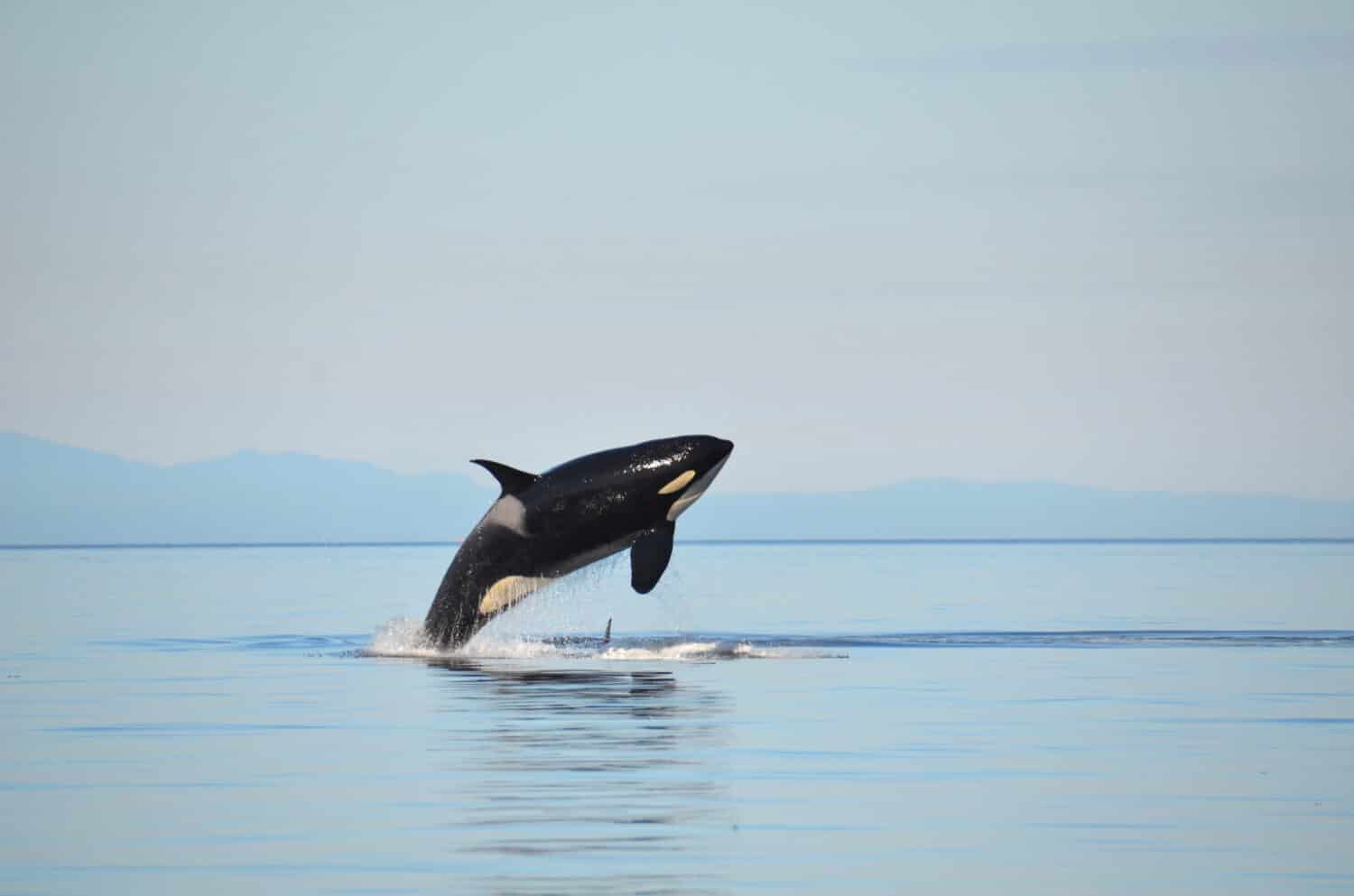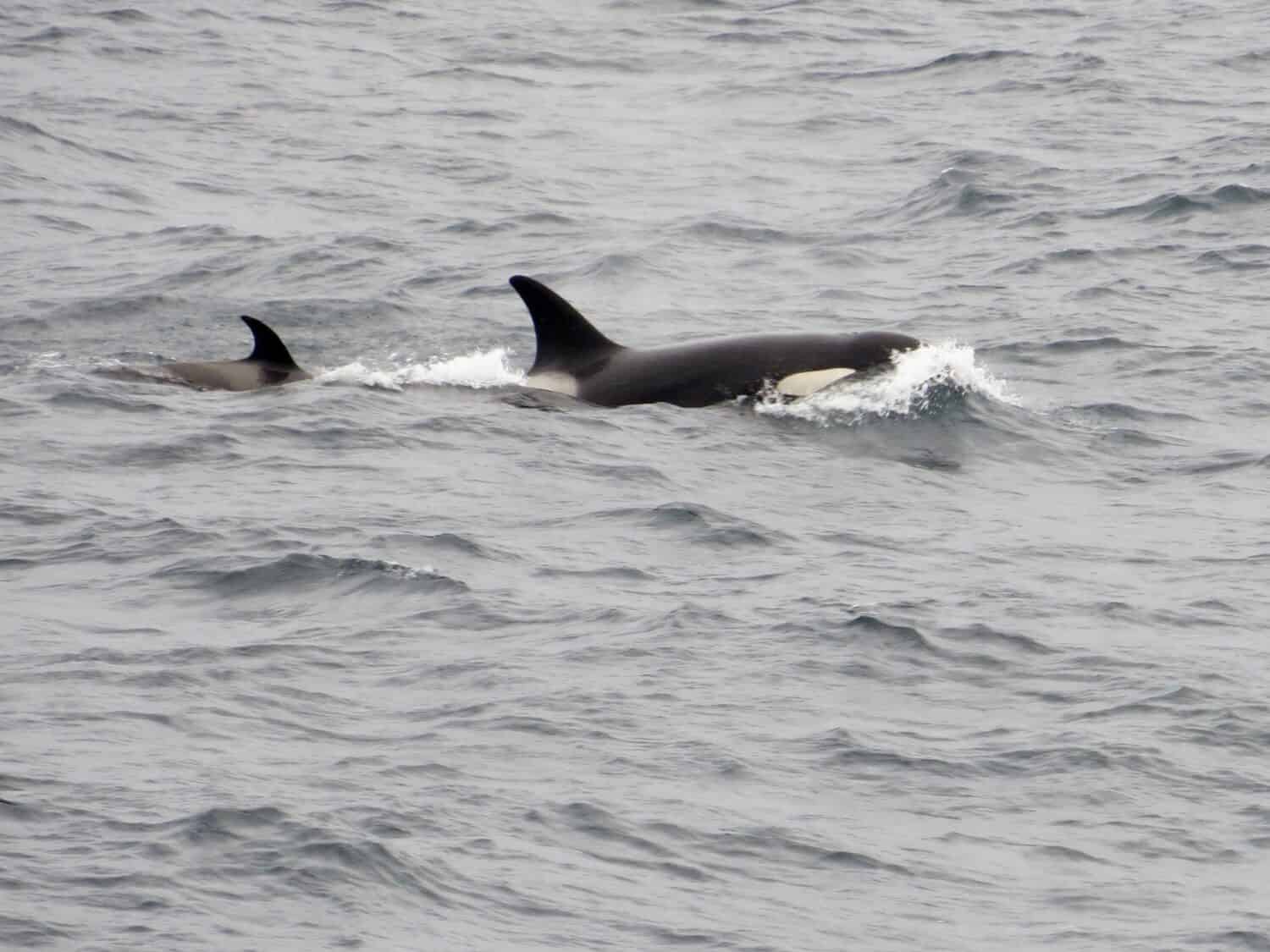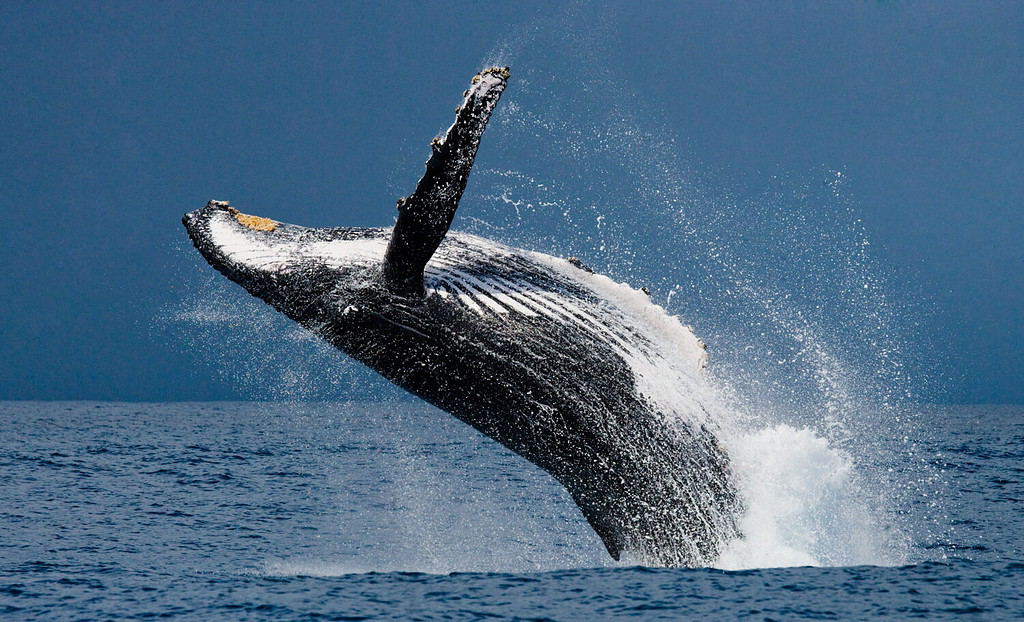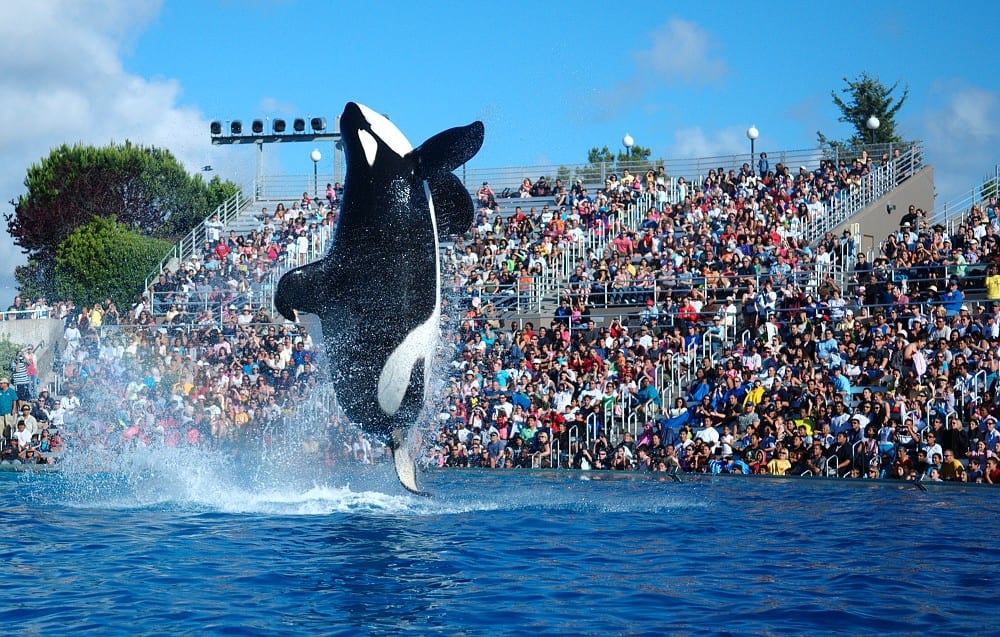The killer whale, or orca, is not actually a whale, but the biggest specie of dolphin, as they belong to the family Delphinidae. Other dolphin species named after whales include the short-finned and long-finned pilot whales. Orcas are one of the most recognizable sea creatures with their distinguished black bodies, with white bellies. Furthermore, they have a cape or saddle on their backs in the form of a gray patch. It’s located just behind the dorsal fin. Their unique coloring is a form of camouflage as the pattern obscures the outline of their bodies but contradicts the body shape. Therefore, their prey usually doesn’t realize these predators are close until it’s too late. While it’s common knowledge that orcas are large, just how big do they get? Below is a killer whale size comparison. Learn all there is to know about these whales.
Killer Whale Size
There are several types of killer whales that differ in size, behaviors, appearance, dialects, prey preferences, social groups, and foraging techniques. While these killer whales are genetically distinct, their ranges often overlap, but researchers believe they do not interbreed or interact with each other.
Southern Resident Killer Whale
Also known as the southern resident orca, these killer whales are the smallest. They do not interbreed with other types of orcas, and they live in exclusively fish-eating communities in the northeast region of the North Pacific Ocean. Southern resident female killer whales typically grow to an average of 18 to 22 feet and weigh between 8,000 to 11,000 pounds, while males measure 20 to 26 feet, and weigh 12,000 pounds, sometimes more.

Also known as the southern resident orca, these killer whales are the smallest.
Image: Monika Wieland Shields, Shutterstock
©Monika Wieland Shields/Shutterstock.com
Bigg’s Killer Whale
The Bigg’s killer whale is larger than the southern resident orca, as they can grow to lengths of 26 feet. These killer whales primarily occur between the Arctic and Baja California in Mexico. However, they are migratory orcas that travel across vast ranges and prey on large mammals.

The Bigg’s killer whale is larger than the southern resident orca, as they can grow to lengths of 26 feet.
Image: Erin Underwood, Shutterstock
©Erin Underwood/Shutterstock.com
Offshore Killer Whale
The offshore killer whale is the most elusive orca species in the northern hemisphere. The reason why these killer whales are so elusive is that they hunt in open waters, far from busy shorelines, so as a result, they are rarely sighted. Offshore killer whales occur mainly off the coast of California, but their range extends all the way to Russia. Females typically measure around 18 feet long, but males can get much bigger.

The offshore killer whale is the most elusive orca species in the northern hemisphere.
©Tory Kallman/Shutterstock.com
Northern Atlantic Type 1 Killer Whale
The northern Atlantic type 1 killer whale predominantly inhabits the regions of Norway, Iceland, and Scotland. They are small-sized orcas, with females measuring 16 to 19 feet long while males grow between 19 to 22 feet.
Northern Atlantic Type 2 Killer Whale
The northern Atlantic type 2 killer whale primarily occurs off the coasts of Iceland and Norway. However, they sometimes travel as far south as the Azores. These orcas are bigger than the northern Atlantic type 1 killer whales and have very obvious white patches over their eyes, with a prominent saddle. Type 2 orcas are one of the biggest species, as males grow to 29 feet long.
Antarctic Type A Killer Whale
The largest species of killer whale is the Antarctic type A killer whale. These orcas can grow up to 32 feet long. The reason these killer whales get so big is due to their diet, which consists of large prey. They often hunt minke whales, which they follow through the Antarctic waters and north into the parts of the Southern Hemisphere. Furthermore, they are also known to hunt seals off the coast of Argentina, where most documentarians go to get footage of these orcas as they beach themselves to feed on the sea lion pups ashore.

The largest species of killer whale is the Antarctic type A killer whale. These orcas can grow up to 32 feet long.
Image: Dale Lorna Jacobsen, Shutterstock
©Dale Lorna Jacobsen/Shutterstock.com
How Big is a Killer Whale Compared to a Bus?
Adult killer whales are almost the same size as a bus! It may be hard to see their total size from the water, but on average, orcas are as long as a small school bus, approximately 19 to 26 feet long. Furthermore, these massive dolphins can weigh up to six tons.
How Big Are Killer Whale Calves When They Are Born?
Killer whale calves may be babies, but they certainly don’t look like it. Both female and male orcas measure around 7.9 feet at birth. Additionally, they usually weigh about 400 pounds. Female orcas must carry their offspring for 15 to 18 months before giving birth, much longer than humans.

Both female and male orcas measure around 7.9 feet at birth.
©slowmotiongli/Shutterstock.com
Largest Killer Whale Ever Recorded
The largest killer whale ever recorded weighed a whopping 10 tons and measured 32.1 feet! As a result, this orca was nearly as heavy as two fully-grown male African elephants. The average weight of a killer whale is typically six tons, so this massive orca was really a sight to behold.
Is a Killer Whale Bigger than a Humpback Whale?
While killer whales are quite large, the humpback whale is much bigger. For example, humpback whales typically weigh 66,000 pounds, female orcas weigh 5,000 pounds, and male killer whales weigh approximately 10,000 pounds. But, despite the size difference, killer whales actively hunt humpback whales, especially their calves. Killer whales live up to their nickname, “wolves of the sea,” because they prefer to hunt large mammals in pods. However, what has shocked researcher is that humpback whales, usually known as gentle giants, fight back. Scientists have observed humpbacks attacking killer whales while they pursue other prey. For example, during one sighting, a pod of 14 humpback whales prevented a pod of killer whales from feeding on their kill.

Humpback whales typically weigh 66,000 pounds, female orcas weigh 5,000 pounds, and male killer whales weigh approximately 10,000 pounds.
©GUDKOV ANDREY/Shutterstock.com
Killer Whale Diet
Considering all killer whale species, they generally eat seals, fish, dolphins, and sea lions. However, they may also consume:
But, some killer whales specialize in hunting specific marine animals and can be picky eaters. Once orca calves adapt to a certain diet, it’s unlikely they will switch to other prey.
Killer Whale Communication
Orcas communicate through various vocalizations and calls unique to every pod. The elders pass down all their knowledge to the juveniles, like what to hunt, where to locate prey, how to catch prey, and which animals to avoid.
Killer Whale Threats
While these orcas have the name killer whale, they face several threats. For example, they accidentally get caught in fishing nets and other gear and succumb to toxic waste and pollution pumped into the ocean. Furthermore, they are susceptible to boat traffic, which can result in collisions and underwater noise pollution caused by boat traffic.
Killer whales are still subjected to whaling in some areas, like Japan, Greenland, Indonesia, and some Caribbean islands. In addition, orcas in the North Atlantic and Pacific Northwest are targets for live capture and sold to places like SeaWorld. As a result, the southern resident species were extensively targeted, and their population numbers are struggling to recover.

Orcas in the North Atlantic and Pacific Northwest are targets for live capture and sold to places like SeaWorld.
©Yathin S Krishnappa, CC BY-SA 3.0, via Wikimedia Commons – Original / License
The photo featured at the top of this post is © Tory Kallman/Shutterstock.com
Thank you for reading! Have some feedback for us? Contact the AZ Animals editorial team.







